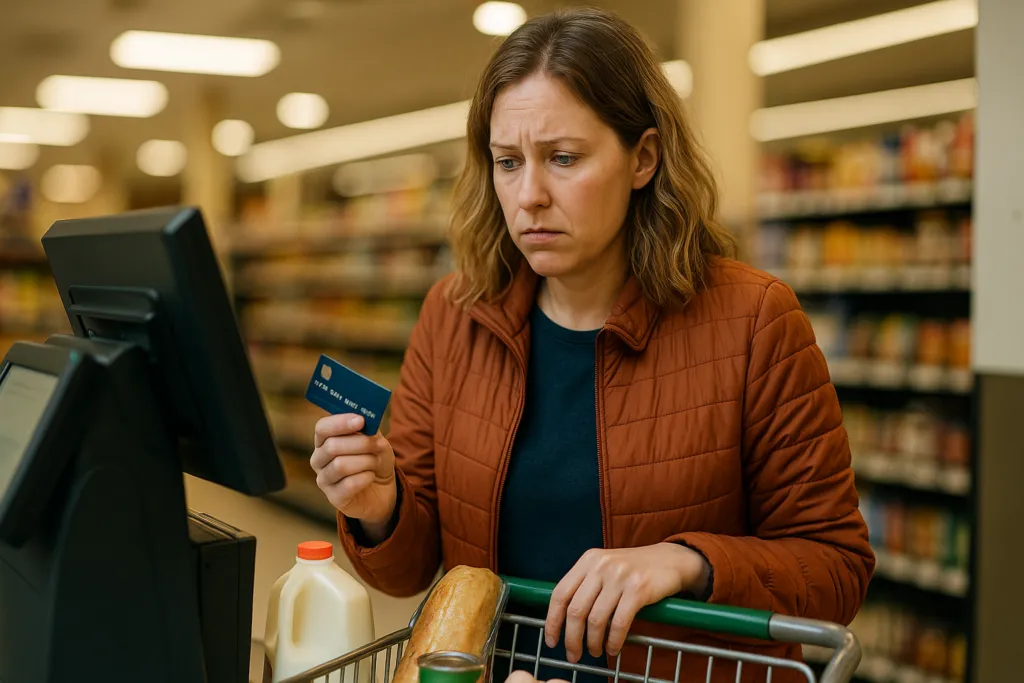Grocery Cart Anxiety: What Shopping With Credit Card Debt Feels Like

Today’s economy makes grocery shopping a real challenge for many folks who are wrestling with credit card bills that just won’t go away. The way people behave in stores shows how they try to juggle spending when credit card debt is hanging over their heads, especially with those sky-high interest rates and tiny minimum payments. It also reveals a bigger picture where many Americans end up leaning on credit instead of building up savings.
Ditching the Cart and Doing the Math on the Fly
One habit people have picked up is the intentional abandonment of their shopping carts. Many customers drop their carts partway through their trip after doing some head-scratching math about how a 24.99% APR will affect their purchases. As they mentally crunch the numbers, they adjust their list to only grab what they can handle paying off with the minimum payments. What seems like a simple $200 grocery run can end up costing $260 thanks to compound interest.
This behavior highlights the tightrope walk of managing daily needs while keeping an eye on longer-term debt. Shoppers are forced to rethink their decisions in real time, constantly weighing how each extra item might mess with their ability to keep up with those minimum payments.
Juggling Splurge and Save Items
Another interesting trend is shoppers buying a bit of both the fancy stuff and the basics. They mix in little luxuries like organic free-range eggs and artisanal cheese with budget picks such as cheap pasta and generic crackers. This combo helps them hold onto a sense of choice and self-respect even when money is tight.
By pairing premium finds with everyday items, consumers face the tug-of-war between wanting quality and needing to stick to a budget. Picking and choosing which items to treat themselves on gives them a feeling of control over their spending, even when dollars are few and far between.
Leveraging Tech for On-the-Spot Money Checks
Technology is a big helper during these grocery trips. You can often see shoppers pulling out their phones—not just for recipes or lists but to run quick calculations on things like credit utilization and debt-to-income ratios. This habit shows just how aware many people are of how their shopping habits relate to the bigger picture of their finances.
Shoppers also tread carefully around store credit offers. When presented with the chance to sign up for a store credit card, most hesitate while they mull over what it might do to their credit scores, especially since some inquiries are considered hard pulls while others are soft.
Talking Through Purchases and Stocking Up
Another behavior that stands out is when people explain their purchases out loud—even when no one’s listening. Comments like “These steaks are for a special occasion,” or “I hardly ever buy this brand,” serve as a way to justify their choices made under financial pressure.
Plus, many turn to buying bulk sale items—like snapping up ten tubes of toothpaste—to hit rewards thresholds and squeeze more value from every dollar. This bulk buying trend is a sign of underlying money worries, as shoppers try to make each purchase stretch as far as possible.
Constantly Checking Loyalty Apps for Rewards
It’s not unusual to see folks refreshing their loyalty apps over and over while in the store. They’re always on the lookout for points, cashback offers, and bonus categories that might help soften the blow from rising interest charges. Many know exactly which cards deliver specific rewards and bonuses—showing just how much these strategies have woven their way into everyday shopping.
Overall, these shopping habits reveal how people are adapting to a system where credit takes the place of savings. Instead of labeling these actions as faults, it’s better to see them as reasonable moves by consumers trying to navigate an often tough financial landscape.
Recognizing these patterns can prompt more understanding rather than quick judgment for those struggling in this environment. As people continue to creatively adjust their spending within these limits, it’s important for everyone to get a better grip on the larger issues that keep so many of us leaning on credit instead of saving up for a rainy day.